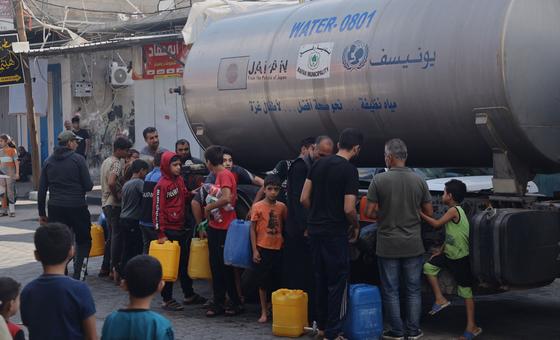Some 3,000 tonnes of supplies have been awaiting entry on the Egyptian side of the crossing since Saturday. On Wednesday, the UN Security Council failed to agree on a resolution that would have called for “humanitarian pauses” for aid delivery.
UN chief expected in Cairo
UN Secretary-General António Guterres was expected to arrive in Cairo within the next few hours, to pursue his diplomatic efforts, following his call for an “immediate humanitarian ceasefire” in the wake of a strike on Al Ahli Arab Hospital in Gaza City on Tuesday, which killed 471 people according to Gaza’s de facto authorities.
UN humanitarian coordination office OCHA said that this was the deadliest incident in Gaza since hostilities escalated and that children, health care staff and internally displaced people were among the victims.
Lives on the line
Commenting on the news of a US-brokered deal, UN health agency WHO chief Tedros Adhanom Ghebreyesus welcomed “USA’s leadership and Israel’s agreement to allow food, water and medical aid” into the sealed off enclave through the Rafah border crossing, stressing on social media platform X that “many lives depend on this happening”.
Briefing the Security Council on Wednesday, UN relief chief Martin Griffiths stressed the need for humanitarian actors to be able to “deliver relief to civilians in need throughout Gaza, without impediment, in places of their choice, in places where they consider themselves to be safe and where we can seek to ensure that safety.”
He told ambassadors that around 100 trucks of humanitarian supplies per day were needed to meet the needs of the more than two million residents of the besieged enclave.
According to news reports, equipment has been sent to repair potholes at the crucial Rafah crossing to allow the initial aid convoy in. More than 100 trucks are waiting for the final green light on the Egyptian side.
Israel has said it would allow limited aid into the enclave provided none of it benefits Hamas, which controls Gaza.
Disastrous situation
Gaza’s population has been facing an increasingly disastrous situation, with a full electricity blackout since 11 October, rising food insecurity and a health system on the brink of collapse.
According to OCHA, the average water consumption for all needs, including drinking, cooking and hygiene is estimated at only three litres per day per person in Gaza. The UN office also warned that people consume water from unsafe sources “risking death and placing the population at risk of infectious disease outbreaks”.
One in two displaced
OCHA reported that about one million people, or close to half of Gaza’s entire population, have been displaced since the start of the conflict.
Over 500,000 are staying in emergency shelters designated as such by the UN agency for Palestine refugees, UNRWA, while Israeli bombardments of the enclave continue.

